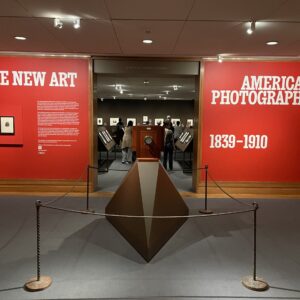JTF (just the facts): Published in 2020 by Steidl (here). Otabind softcover with dust jacket. 19 x 30.5 cm, 96 pages, with 45 monochrome images. Includes an essay by the artist. Designed by the artist. (Cover and spread shots below.)
Comments/Context: Memory can be an unreliable historian. While that’s true for everyone, Tenzing Dakpa’s past—compiled from scattered records, mental images, and the vague recollections of family members—is less certain than most. He might have been born in Kalimpong, West Bengal. Or perhaps it was in Gangtok, Sikkim. The exact date is iffy too. His birth certificate lists November 21, 1985, but his aunt remembers the year being much earlier. He can’t appeal to his older brother or his parents to help sort the facts. Their birth dates are just as fuzzy, lost in the haze of exile. His mother’s family fled the 1959 Chinese annexation of Tibet—the name “Tenzing” is Tibetan—arriving eventually in Sikkim by way of Bhutan. As for his father, old pictures show him “in a landscape that could be anywhere between Bhutan and Kalimpong.”
With such tenuous roots, one could hardly blame Pala and Amla Dakpa for planting a firm foundation when the opportunity arose. Once settled for good in Gangtok, they built the Lhasa Hotel, a five story lodge and restaurant catering to tourism. This became the family business. Tenzing’s parents and brother still run the place, and he worked there too before moving away in 2004 to pursue his photography career. Returning later on annual visits, the prodigal son found himself drawn to his childhood haunts with newfound interest. Perhaps the downtime of vacation opened photographic possibilities. Or it may have been the hotel’s resident cat Dungkhar, coming and going at will, in whom Dakpa imagined his alter ego. Photography’s inherent documentary nature must have also been a lure. Nagged by his unsettled past, the chance to nail down current facts was probably motivational.
Dakpa began to photograph his family, more particularly their environs. The resulting pictures comprise his recent monograph The Hotel. His entree into the project was Dungkhar. “I projected myself a lot onto this cat,” says Tenzing. “I would just observe, follow and photograph him around the premises of the hotel, which is a five-storey building. Up until this point, I always found it difficult—and was not interested in—photographing in Gangtok or my home. I always considered Gangtok to be a place of rest and inactivity. Dungkhar had, by proxy, taught me how to photograph my home, and my boredom in the process.”
Dungkhar—who has sadly since disappeared—will be the subject of an upcoming monograph with TIS. In The Hotel he appears only sporadically in a handful of photographs. But his curious wanderings help to unify the book. In some ways he is a totem for the photographic process, with its halting rhythms of exploration, patient observation, and occasional pounces. If a photographer is skilled and lucky the hunt might land some game. Two photos of Dungkhar captured amid shadows are both clean kills. In one he stands along against a jagged staircase. In the other he creeps along the top of a wall. Both are sharply composed, with stark blocks of black and white framing the young cat into formal chiaroscuros.
In another picture Dunghkar sits atop a TV set in the soft light of a hotel room, peering over the edge at some imagined prey below. The next image shows the same setting from the same vantage. But now the lighting has shifted to the interior, white sheets cover the furniture, and Dunghkar has vanished. The two pictures are so dissimilar that it requires some back and forth to confirm they show the same room. A later pairing in the book also hints at the fickle nature of reality, with a dining table alternating from stuffed to empty like the flick of a light switch. Is this what a hotel might look like from a cat’s perspective, with rooms, people, and lighting in constant flux, its humanoid systems beyond easy comprehension?
Dunghkar’s alien viewpoint is a guiding light for Dakpa, one he seems to want for himself. But of course he is intimately familiar with every inch of the hotel. The tension between these perspectives becomes the book’s animating force, as Dakpa attempts to capture mundane scenes with fresh eyes. It’s the same cognitive dissonance faced by some previous photographers photographing their families, Larry Sultan for example, or Richard Billingham (both cited by Dakpa as influential). Strategies vary but all require some degree of mental gymnastics. Dakpa’s might be exemplified in a poster he photographed in a hotel stairwell. It’s a cartoon drawing of a man contorting his head between his legs to peer at his own ass from behind. “Get to know yourself” reads the text. This helpful reminder is a graphic which Dakpa has known since childhood and passed by thousands of times. Nevertheless he attempts to observe and obey it without prejudgment, as an outsider might, or perhaps a cat.
Dakpa’s takes a similar approach to his parents and brother, with mixed success. “I want to figure out who we are and what we do and I want to know more about you,” he said to his father as he embarked on the project. But for most readers his parents will remain a cipher. He follows them around the hotel as they perform various domestic duties, watering the garden, cooking meals, dusting the tile floors and changing sheets. Dakpa’s snapshot aesthetic, with stark flash lighting up candid moments, captures a fly-on-the-wall cinema verite version of hotel life. His father stares out the window, climbs stairs, hangs a curtain rod, etc. His mother pierces the lens with looks of blank curiosity while his brother enjoys a snack and brushes his teeth. Dakpa’s depiction seem faithful to reality, but it is strangely dispassionate. Dakpa’s parents are well acclimated to their son’s strange documentary obsession, either ignoring his gaze or giving cursory acknowledgement. But, perhaps consumed with running a business, they do not take much time to engage with his camera. Considering their peripatetic past, perhaps an indefinite depiction is an honest one.
Dakpa’s immediate family of course plays an outsized role in his life, and the book is dedicated to Pala and Amla. But in The Hotel they take a backseat to the title character. The hotel’s presence looms throughout the book, beginning with its very shape. The vertical portrait format seems disconcertingly tall at first, until one realizes that it mimics the form of a five-story hotel. The Lhasa Hotel is a beanstalk of a building with a narrow footprint tucked into a small lot in Gangtok. We learn all of this from the book’s dust jacket, which reproduces blueprints of the original architectural drawings. The building’s size and location are shown, imbued with a measure of dreamy ambition. The Dakpas had some chutzpah to get this thing off the page and into reality. Just inside the cover is a scrap of hotel stationery, lest anyone doubt the place is real.
All of Dakpa’s pictures are horizontal format, and their layout in a book with exaggerated verticality maroons them in big banks of space. There are no captions or fancy graphics, just pictures appearing stage right. The design seems intended to mirror the modest white cleanliness of the hotel’s decor, with pockets of information jostling amid bare floors, walls, and sheets. No guests are shown, no staff or people except the Dakpas. Theirs is a near platonic ideal of “hotel”. Gerhard Steidl might be describing the building itself when he writes, “what I particularly like about this book is the absence of too much design. It’s just pure photography printed on paper.” Beyond the brief colophon with this passage, the book’s only text comes on a single separate page. It’s inserted into the book like a checkout notice slipped under a guest’s door. Titled Family and Memory, the essay is Dakpa’s heartfelt outline of recent family roots.
If his past is somewhat fuzzy, Tenzing Dakpa’s future is less so. Stints at New Delhi’s College of Art and RISD have given him some footing in the fine art photo world, followed by shows in London, Mack’s shortlist, and a feature in Aperture. These achievements culminated in the Photobook Award at the Singapore International Photography Festival, paving the way to the current Steidl book. He seems well on his way, and the hotel will soon be in the rearview. The final photograph in the book encapsulates these shifting prospects. It’s taken from the passenger seat, showing a car interior. Through the window one can see distant hills, presumably in the vicinity of Gangtok, the car presumably prepped for departure. This is the only image in the book not made inside the hotel. It still has a foot in that world, but its momentum is directed elsewhere.
Collector’s POV: Tenzing Dakpa does not appear to have consistent gallery representation at this time. Interested collectors should follow up directly with this artist via his website (linked in the sidebar).

























